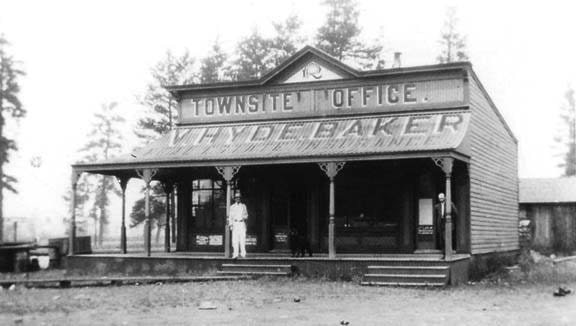Jim Cameron
If the real estate maxim "Location, location, location" is accurate, it would account for much of the success of early Cranbrook.
Situated on a wide prairie amidst rolling hills — a veritable sportsman's paradise in a valley that literally forces travelers through its course — that alone would likely have meant that something similar to Cranbrook would have arisen up with time.
The fact that it centered the once very profitable Wildhorse, St. Eugene, North Star, and Perry Creek mining operations certainly didn't hurt. Farm and ranchland in abundance, water and lumber all contributed to its success but, without a doubt, it was the arrival of the CPR in 1898 that truly put it on the map.
Well, actually it was on the map already — the surveying of the townsite had been accomplished somewhat earlier. What it really needed was people and those began to arrive early in 1898, months before the first locomotive.
Among the very first buildings erected in town was a small newspaper office in the vicinity of 9th Avenue and 1st Street. The Herald published its first paper on March 22, 1898, in which it guaranteed a weekly circulation of 1,000 copies ...somewhere. There was little local news to report because there were few people to make it or read it. What did matter was the fact that people from outside the area began reading the paper and the paper did all it could to boost the largely imagined town of Cranbrook.
It is "A town of opportunities," the weekly bragged, "which, before the snow flies, will be a divisional point, a junction of the North Star Mine Branch and will also have a smelter in course of erection.
"Cranbrook property will increase in value more rapidly than property in any other town in the South East Kootenay," the paper went on. "At this time any man has a chance to get in on the ground floor." And you know what? It was right, with the exception of the smelter, which never bloomed.
There were eight local advertisements mingled among the four pages of the Herald edition of April 5: two hotels (the Cranbrook and the East Kootenay), Hilliard's Blacksmithing, the Cranbrook Lumber Co., Dr. Hugh Watt (travelling dentist), two contractor-builders (Kaake & Sibald) and an ad for the Herald newspaper itself (fifty-two issues for $2.00).
Within a month one more ad joined the old gang. It belonged to John Hutchison and it read, "Pioneer real estate, mining and insurance broker. Buildings to rent and for sale. Particular attention given to making safe investments for clients."
The "pioneer" was a bit of a stretch considering Mr. Hutchison had only been here for a few months, but apparently it counted for something as business was brisk. Very brisk. Really, really brisk.
The original townsite, surveyed under the auspices of local landowner James Baker, was, by 1898, split between himself and the CPR, an enticement on Mr. Baker's part to convince the railway to come this way. Although only a matter of (very roughly) perhaps fifty blocks all told, the land within the townsite that first caught investor's eyes translated into something in the area of 1,135 individual lots. This, at an average of $200 per lot, translated into a value of $227,000. It may not sound like big bucks but by today's standards it would easily be well over $5,000,000, and that is nothing to sneeze at.
Yes indeed, there was money to be made and, unlike the early pioneers on the scene, many of them miners, there were some who now understood the money was not in what might be found in the land but rather the land itself. The townsite office did a booming business.
Operated by the team of Valentine Hyde Baker, son of James, and the CPR, it advertised "The Canadian Pacific Railway Co. Lands Agency. Lots in all parts of the city for sale." And sell them they did. Along one block of Baker Street at first, and along Van Horne Street near the site of the proposed railway station. Then spanning further out from 3rd to 14th Avenue, from 1st to 2nd Street and especially on what would soon become known as "Baker Hill."
The hill was a natural choice for those with money to spend. It was relatively clear of the smoke, dust and noise of the business and industrial district, it had a wonderful view, and, face it, it was higher up than the workingmen’s cottages filling the flatlands. It was a clear-cut case of white collar up and blue collar down.
Real estate prices began to rise as speculators bought land to re-sell, improved or otherwise, to those who came after. The Herald of August 4 boasted that there were more lots sold in Cranbrook in the last two weeks than in all other towns in the South East Kootenay in the last two months. Housing was at a premium and local tourists, soon to arrive in ever increasing numbers with the coming of the rails, complained of the noise made by the many local carpenters. Work commenced along the creeks and springs in the north and east end, clearing the cottonwood and undergrowth and opening Baker Street eastward.
Local surveyor Archibald McVittie teamed up with John Hutchison to form the first independent real estate company in town. They soon expanded into insurance and money-lending (in sums from $100 to 1,000). They even offered to build houses for rent to suit every customer. The hotels and boarding-houses, going up just as rapidly as the residences, were full to overflowing.
Construction would go on throughout the winter, the buying and selling of real estate would continue for somewhat longer.
